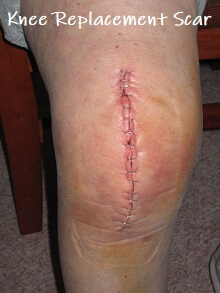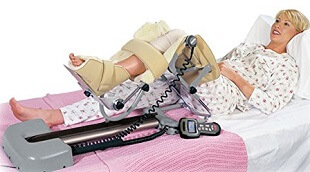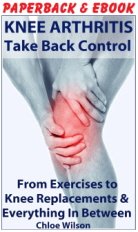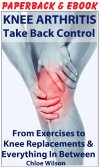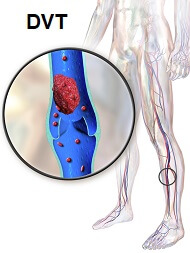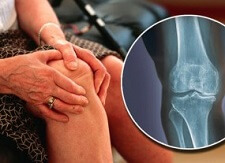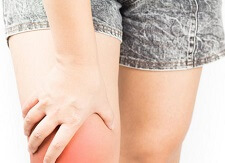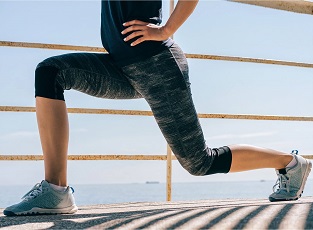- Home
- Knee Surgery
- Knee Replacements
- Common Problems
Knee Replacement Problems
Written By: Chloe Wilson, BSc(Hons) Physiotherapy
Reviewed by: KPE Medical Review Board
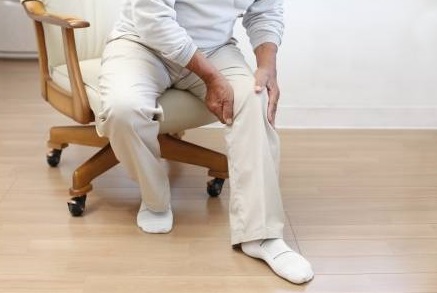
Knee replacement problems are usually fairly minor and short lived, with approximately 90% of knee replacements being extremely successful.
Unfortunately, problems do occasionally develop. All surgery carries risks and in the early days following a knee replacement, things can feel uncomfortable.
The best way to ensure you make a great recovery after a knee replacement is to do knee replacement exercises both before and after surgery until you have regained full movement, strength and function in your new knee.
Here we will look at the most common total knee replacement problems people experience in both the short term and long term, the risks associated with having surgery and how to tell if something is really wrong. Alternatively, visit the partial knee replacement problems section.
Common Short Term Knee Replacement Problems
The most common short term knee replacement problems tend to be fairly minor and settle down within a few weeks:
1. Knee Pain
Some pain after a knee replacement is to be expected but this doesn't usually last long. In fact, people often find that they have less pain than they did before their knee replacement surgery as they no longer have any arthritis knee pain and the knee is able to move more freely.
When you wake up after knee replacement surgery, there shouldn't be much pain as the anesthesia will still be working to some extent. Once the anesthesia starts to wear off, the knee may feel sore both inside the knee and around the scar initially.
It is really important to be having effective pain relief to keep this under control. Don't try and manage without medication too quickly. It is much better to take prescribed medication to keep the pain under control so you can start you rehab exercises and get up and about otherwise you may develop other knee replacement problem such as stiffness and weakness.
2. Numbness
Another common knee replacement problem people sometimes find is that it may also feel slightly numb around their scar – this can happen because some of the small nerves that supply feeling to the skin are cut during knee replacement surgery.
Nerves can take up to two years to fully heal so you may notice improvement up until then. Any resultant numbness after that time is not likely to change.
3. Knee Swelling
Swelling is one of the most common knee replacement problems. There is usually swelling around the knee for the first few days after surgery. The knee is initially bandaged to help reduce this. Once the bandage is removed, tubigrip compression bandages can be used to help reduce the swelling and support the knee.
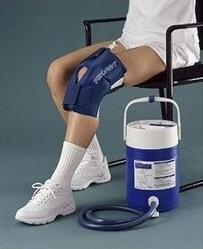
Keeping the leg elevated when you are lying down or sitting helps the excess fluid drain away from the knee and reduce swelling.
Another thing that can help is using ice therapy. When used properly, this helps to slow the blood flow and any bleeding in the joint, reducing knee swelling. There are a number of different ways to apply ice after a knee replacement. Cryo cuffs are often used in hospitals and once you get home you can use an ice pack - find out more in the ice wraps section.
Movement and exercise is another great way to reduce swelling after knee replacement surgery as it pumps any excess fluid out of the joint. However, you have to get the right balance - if you try and do too much too soon, you can actually make the swelling worse. Follow the guidance of your physical therapist.
4. Strange Noises
Sometimes people find that their knee makes funny creaking/cracking/
popping noises after a knee replacement. This is nothing to worry about
and usually settles down within a few months as everything heals.
5. Stiffness
Many people struggle with some stiffness in their knee in the early days after a knee replacement, particularly if their movement was affected before the operation.
Working on your rehab program is one of the best ways to avoid this. You are aiming to be able to get the knee fully straight and be able to bend it at least 100o.
Some surgeons like their patients to use a CPM machine (continuous passive motion) initially to help reduce knee replacement problems. A CPM automatically bends your knee up and down and the amount of movement can be adjusted to gradually increase how much the knee bends. CPM's are a great tool for helping reduce knee stiffness but they are not a replacement for exercises - your knee needs to be actively using its muscles to move too.
If stiffness continues to be a problem longer term after your knee replacement, then your doctor may want to do a manipulation under anaesthetic (MUA) where they put you to sleep and bend your knee to break down any scar tissue or adhesions that have formed.
You can find out more about knee range of motion and how to improve it.
Long Term Knee Replacement Problems
Check Out Our Book
All the info you need about knee arthritis, top tips, exercises & loads more.
Rated 4.4/5
Find Out More
Longer term knee replacement problems are rare but include:
- Wearing of the Prosthesis: 85% of knee replacements last at least 20 years
- Loosening of the Prosthesis: 1.4% of patients require a repeat total knee replacement, known as a revision knee replacement
- Infection in the Knee Joint: this can occur years after surgery
Risks of Surgery
With any surgery, there are risks including bleeding and infection. Risks for anaesthesia include breathing problems and reactions to the medications.
Specific risks associated with knee replacements include:
- Blood Clots: also known as deep vein thrombosis or DVT, these can travel around the body and cause problems such as heart attack or stroke
- Infection: usually at the site but the infection can spread around your body.
- Blood Vessel/Nerve Damage: may affect the sensation around the knee joint
- Pain Kneeling: you may need to kneel on a cushion
- Complex Regional Pain Syndrome: rare problem with circulation and sensation leading to pain and swelling
How Do I Know If Something's Wrong?
Whilst serious knee replacement problems are rare they can occur. Signs to watch out for are:
- Worsening or Extreme Pain: That doesn't settle down with medication
- Intense Swelling: around the knee or in the calf
- Redness: around the knee, particularly along the scar
- Fever: raised temperature
- Calf Pain: intense pain, redness, swelling or warmth in the calf region may indicate a DVT
If you develop any of these post knee replacement problems talk to your doctor immediately.
Find Out More
If you want to know more about knee replacement surgery, visit the sections below:
- Knee Replacement Overview: Including how to tell if you would benefit from surgery
- TKR Surgery: What actually happens during the operation
- Rehab: Including what you can do to get the best results
- Common Questions: Frequently asked questions after knee replacements
- Knee Replacement Video: Watch an animated guide or real footage from a TKR
- Partial Knee Replacements: Less invasive surgery where only one side of the knee is replaced
- Knee Replacement Book: Everything you need to know in a handy book
Page Last Updated: 11/10/21
Next Review Due: 11/10/23
